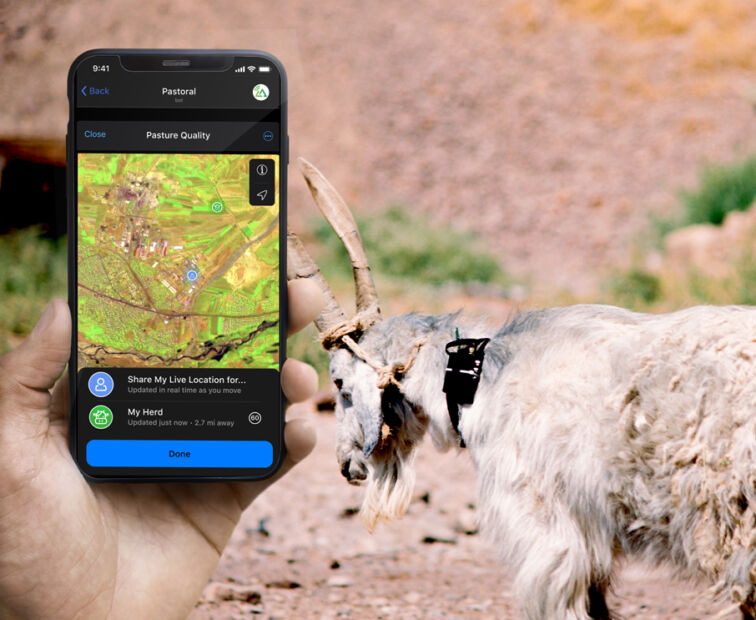Keeping IoT simple down on the farm
- October 28, 2022
- Steve Rogerson

A UN spin out has simplified IoT technology to make it affordable for farmers in poorer countries. Steve Rogerson checked it out.
Do you ever think IoT technology is just a little bit too complicated? Or even too expensive?
This was a problem the United Nations was trying to get its head round when it came to helping livestock farmers in poorer countries operate more sustainably. In particular, if you have too many animals grazing on the same piece of land for too long, that patch becomes effectively useless.
Now, IoT technology exists and is in use by many farmers around the world to track the livestock and monitor where they are and their health, and then make decisions based on the information. The trouble is that such technology is too expensive for farmers in many countries.
The UN put this problem to its Karakoram division, which Josh Thomas, who worked for the division, described when I chatted with him this week as a bit like the Q branch from the James Bond movies, where they come up with clever ideas. They came up with a clever idea that led to Josh and Shea McManigal forming a spin-out company called Pastoral to put the idea into practice.
“What we wanted to do,” said Josh, “was use artificial intelligence, the IoT and machine learning to make more profit for farmers with less environmental impact. This is popular in wealthier countries. We have taken similar technology and worked out how to make it work in lower income areas.”
Rather than developing their own app, they found the existing Telegram app had features that could be adapted to their use and was already used for messaging by many farmers, so no need for them to install anything else on their phones.
The next problem was tracking the animals. To make farming more sustainable, the animals ideally move a little every day. If they are penned in, they can become ill. So they decided to use satellite data to see where the grass is recovering, and put virtual fences around the animals. If they leave the fence, the technology sends an alert.
However, to set up such a system would normally involve building pylons and RF beacons. That costs money.
“We took a different route,” said Josh. “We opted for solar power and 2G. We love working with 2G.”
Now, hang on a minute. Isn’t everyone turning 2G off? Well, yes and no. The developed countries have or are turning it off but it is still very much the base in poorer countries and they will still have it running for many years. However, Pastoral has designed the system so it will jump to 3G if necessary, and only if necessary.
“I hate 3G because it is horrible for the type of tools we have,” said Josh. “We are the opposite of most technology companies that are obsessed with 5G; 2G is the best for this. But 3G works almost as well and is better than 4G and 5G for this type of application.”
They also looked at LoRa but realised the infrastructure just wasn’t there and there would be a cost involved.
“We tested LoRa and it costs more than 2G,” said Josh. “Also, governments may not like you adding the necessary infrastructure. Long term, we may reengage with LoRa. I hope that by the time 3G is turned off, these countries will have LoRa or Helium. I hope it is Helium; I am a Helium nerd.”
To get the positioning information, the devices Pastoral has built use GPS.
The next problem was monitoring the health of the animals to which the devices are attached. Again, keeping it simple was again the aim. No fancy smartwatches or patches here, the device just notes how much the animals move each day. If they don’t move a lot, then that suggests something is wrong and the farmer can go out and investigate.
The team began their venture by carrying out product and user trials last year in Uzbekistan, building a rapport with the leaders of a farming collective comprising thousands of livestock farmers earning as little as five dollars per day. The results were astounding. The technology, they discovered, could help farmers increase their profitability by 40% while reducing environmental damage by 30%. Much of this came from reducing pasture degradation in a country that sees 1.5% of its land a year becoming degraded.
With 100% market penetration, Pastoral has estimated there could be a reduction of eight megatonnes of CO2 in Uzbekistan alone. To put that into perspective, livestock farming in Uzbekistan emits 24 megatonnes of CO2 annually, which equates to powering 33.6 million homes for one year or extracting 255 million barrels of oil.
Pastoral won the 2022 Entrepreneur’s Award in Social Innovation (EASI) that comprised a grant of £10,000, a 12-month support and fellowship package including introductions to more sources of funding, as well as access to other opportunities and professional services.
Much of that money has been used to streamline the device that is attached to the animals. It is now looking for more farmers to adopt the technology.
Maybe other sectors should try this keep it simple approach.





